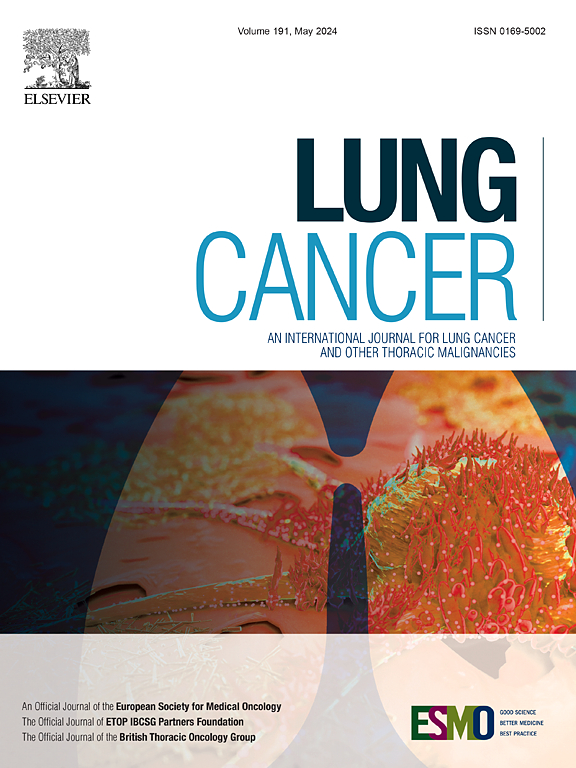ROS1融合对手术切除肺腺癌患者预后的影响及特点
IF 4.4
2区 医学
Q1 ONCOLOGY
引用次数: 0
摘要
目的探讨ROS1融合在手术切除肺腺癌(LUAD)患者预后中的意义。材料和方法纳入2015 - 2020年间连续行全切除和ROS1检测的患者。倾向评分匹配(1:2)用于平衡基线特征。无病生存期(DFS)、总生存期(OS)和累积复发率(CIR)进行总体和TNM分期比较。分析ROS1融合阳性患者的复发模式和复发后生存率(PRS)。结果16779例患者符合纳入标准,其中ROS1融合阳性216例,ROS1融合阴性16563例。配对后,纳入216例ROS1融合阳性和432例ROS1融合阴性患者进行生存分析。在整个队列中,与ROS1融合阴性组相比,ROS1融合阳性组的DFS(5年:72.7%对66.4%,p = 0.074)和OS(5年:87.6%对80.7%,p = 0.055)相似。亚组分析显示,ROS1融合与I期较好的DFS(风险比[HR], 0.609; 95%可信区间[CI], 0.376-0.986; p = 0.043)和OS (HR, 0.481; 95% CI, 0.242-0.958; p = 0.037)相关,II-III期结果相似。此外,复发模式和CIR分析与这些发现一致。在复发的患者中,ROS1酪氨酸激酶抑制剂(TKIs)显著改善了PRS(中位PRS: 65 vs 20个月;p < 0.001)。在多变量Cox回归分析中,ROS1-TKI治疗仍然是PRS的独立保护因素(HR = 0.259; 95% CI, 0.103-0.647; p = 0.004)。结论ros1融合与I期LUAD预后较好相关,ROS1-TKI治疗具有复发后生存优势。本文章由计算机程序翻译,如有差异,请以英文原文为准。
Prognostic impact and characteristics of ROS1 fusion in patients with surgically resected lung adenocarcinoma
Objective
We aimed to investigate the prognostic significance of ROS1 fusion in surgically resected lung adenocarcinoma (LUAD).
Materials and methods
Consecutive patients who underwent complete resection and ROS1 testing between 2015 and 2020 were included. Propensity score matching (1:2) was applied to balance baseline characteristics. Disease-free survival (DFS), overall survival (OS), and cumulative incidence of recurrence (CIR) were compared overall and by TNM stage. Recurrence patterns and post-recurrence survival (PRS) in ROS1 fusion-positive patients were also analyzed.
Results
Overall, 16,779 patients met the inclusion criteria (216 ROS1 fusion-positive and 16,563 ROS1 fusion-negative). After matching, 216 ROS1 fusion-positive and 432 ROS1 fusion-negative patients were included in survival analysis. In the overall cohort, the ROS1 fusion-positive group had similar DFS (5-year: 72.7 % vs. 66.4 %; p = 0.074) and OS (5-year: 87.6 % vs. 80.7 %; p = 0.055) compared with the ROS1 fusion-negative group. Subgroup analysis showed that ROS1 fusion was associated with better DFS (hazard ratio [HR], 0.609; 95 % confidence interval [CI], 0.376–0.986; p = 0.043) and OS (HR, 0.481; 95 % CI, 0.242–0.958; p = 0.037) in stage I, with similar outcomes in stages II–III. In addition, recurrence patterns and CIR analyses were consistent with these findings. Among patients who experienced recurrence, ROS1 tyrosine kinase inhibitors (TKIs) significantly improved PRS (median PRS: 65 vs. 20 months; p < 0.001). In multivariate Cox regression analysis, ROS1-TKI therapy remained an independent protective factor for PRS (HR = 0.259; 95 % CI, 0.103–0.647; p = 0.004).
Conclusion
ROS1 fusion was associated with better prognosis in stage I LUAD, and ROS1-TKI therapy conferred a survival advantage after recurrence.
求助全文
通过发布文献求助,成功后即可免费获取论文全文。
去求助
来源期刊

Lung Cancer
医学-呼吸系统
CiteScore
9.40
自引率
3.80%
发文量
407
审稿时长
25 days
期刊介绍:
Lung Cancer is an international publication covering the clinical, translational and basic science of malignancies of the lung and chest region.Original research articles, early reports, review articles, editorials and correspondence covering the prevention, epidemiology and etiology, basic biology, pathology, clinical assessment, surgery, chemotherapy, radiotherapy, combined treatment modalities, other treatment modalities and outcomes of lung cancer are welcome.
 求助内容:
求助内容: 应助结果提醒方式:
应助结果提醒方式:


